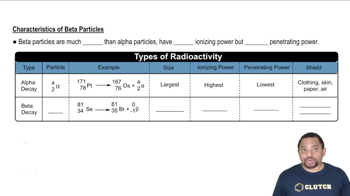Here are the essential concepts you must grasp in order to answer the question correctly.
Radioactive Decay
Radioactive decay is the process by which unstable atomic nuclei lose energy by emitting radiation. This can occur in various forms, including alpha and beta decay. In alpha decay, an atomic nucleus emits an alpha particle (two protons and two neutrons), while in beta decay, a neutron is transformed into a proton, emitting a beta particle (an electron or positron). Understanding these processes is crucial for analyzing decay series.
Recommended video:
Rate of Radioactive Decay
Alpha and Beta Particles
Alpha particles are positively charged particles consisting of two protons and two neutrons, effectively reducing the atomic number of the parent nuclide by two and the mass number by four. Beta particles, on the other hand, are high-energy, high-speed electrons or positrons emitted from a decaying nucleus, which increases the atomic number by one without changing the mass number. The type and number of emissions determine the transformation of the original nuclide into a stable product.
Recommended video:
Characteristics of Beta Particles
Decay Series
A decay series is a sequence of radioactive decays that a particular nuclide undergoes until it reaches a stable end product. Each step in the series involves either alpha or beta decay, leading to different intermediate nuclides. In the case of 232Th decaying to 208Pb, tracking the number of alpha and beta emissions is essential to understand the complete transformation and the final stable nuclide formed.
Recommended video:

 Verified step by step guidance
Verified step by step guidance

